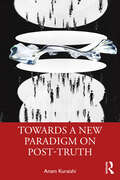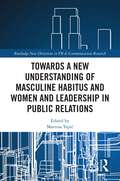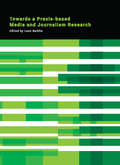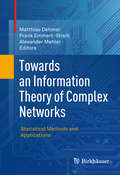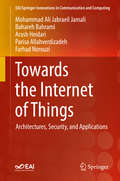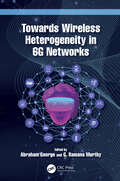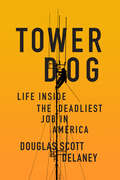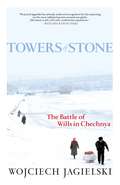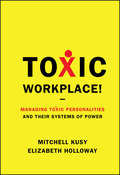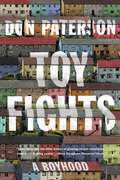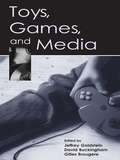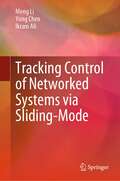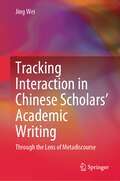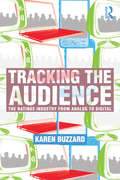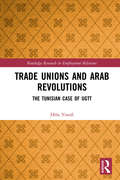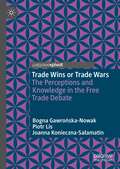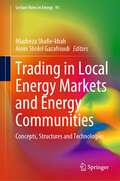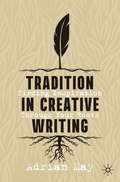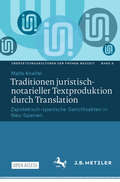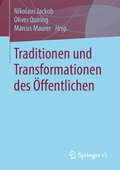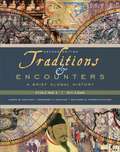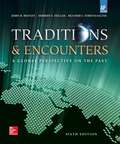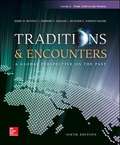- Table View
- List View
Towards a New Paradigm on Post-truth
by Anam KuraishiThis book reconceptualises the idea of “post-truth”. It does not limit the domain of post-truth to the production factories of fake news. Drawing on examples such as Trump, War on Terror, anti-vaccination, climate change denial, denial of scientific facts about smoking, and so forth, it analyses the concept through a new theoretical lens which focuses on the specificity of post-truth discourses. Further, the volume develops a guide to operationalise post-truth discourse and makes use of Pakistan as a case study to illustrate post-truth discourses in Pakistani newspapers and implements an experiment to measure the effects of post-truth rhetoric on political attitudes.The volume will be essential reading for students, scholars, and researchers of media and communication studies, politics, and South Asian studies.
Towards a New Understanding of Masculine Habitus and Women and Leadership in Public Relations (Routledge New Directions in PR & Communication Research)
by Martina TopićThis edited volume analyses leadership in the public relations (PR) industry with a specific focus on women and their leadership styles. It looks at how women lead, the inf luence of the socialisation process on leadership styles, the difference between feminine and masculine leadership styles, and the impact of leadership style on career opportunities for women. The book features case studies exploring leadership in PR around the world in an attempt to answer a central research question: is there a masculine habitus in the PR industry despite the rise of women in PR? The authors of each chapter conducted original research on women working in PR within their own country and provide original insights into the position of women in a feminised industry, as well as proposing new and original theoretical frameworks for future research. Written for scholars, researchers and students of PR and communication, this book will also be of interest to those studying gender studies, leadership and organisational analysis, and sociology.
Towards a Praxis-based Media and Journalism Research
by Leon BarkhoThis volume brings together current scholarly debates about how to bridge the gap between theory and practice in media and journalism research. Drawing on work from media scholars and media practitioners that focuses on how both sides can work together for the good of society, Towards a Praxis-based Media and Journalism Research is the first collection to examine how theory and practice can be combined for positive effect. The result will lay important groundwork for scholarship on this new and increasingly important idea in media and communication studies.
Towards an Information Theory of Complex Networks: Statistical Methods and Applications
by Alexander Mehler Matthias Dehmer Frank Emmert-StreibFor over a decade, complex networks have steadily grown as an important tool across a broad array of academic disciplines, with applications ranging from physics to social media. A tightly organized collection of carefully-selected papers on the subject, Towards an Information Theory of Complex Networks: Statistical Methods and Applications presents theoretical and practical results about information-theoretic and statistical models of complex networks in the natural sciences and humanities. The book's major goal is to advocate and promote a combination of graph-theoretic, information-theoretic, and statistical methods as a way to better understand and characterize real-world networks. This volume is the first to present a self-contained, comprehensive overview of information-theoretic models of complex networks with an emphasis on applications. As such, it marks a first step toward establishing advanced statistical information theory as a unified theoretical basis of complex networks for all scientific disciplines and can serve as a valuable resource for a diverse audience of advanced students and professional scientists. While it is primarily intended as a reference for research, the book could also be a useful supplemental graduate text in courses related to information science, graph theory, machine learning, and computational biology, among others.
Towards the Internet of Things: Architectures, Security, and Applications (EAI/Springer Innovations in Communication and Computing)
by Mohammad Ali Jabraeil Jamali Bahareh Bahrami Arash Heidari Parisa Allahverdizadeh Farhad NorouziThis book presents a comprehensive framework for IoT, including its architectures, security, privacy, network communications, and protocols. The book starts by providing an overview of the aforementioned research topics, future directions and open challenges that face the IoT development. The authors then discuss the main architectures in the field, which include Three- and Five-Layer Architectures, Cloud and Fog Based Architectures, a Social IoT Application Architecture. In the security chapter, the authors outline threats and attacks, privacy preservation, trust and authentication, IoT data security, and social awareness. The final chapter presents case studies including smart home, wearables, connected cars, industrial Internet, smart cities, IoT in agriculture, smart retail, energy engagement, IoT in healthcare, and IoT in poultry and farming.Discusses ongoing research into the connection of the physical and virtual worlds;Includes the architecture, security, privacy, communications, and protocols of IoT;Presents a variety of case studies in IoT including wearables, smart cities, and energy management.
Towards Wireless Heterogeneity in 6G Networks
by Abraham George G. Ramana MurthyThe connected world paradigm effectuated through the proliferation of mobile devices, Internet of Things (IoT), and the metaverse will offer novel services in the coming years that need anytime, anywhere, high-speed access. The success of this paradigm will highly depend on the ability of the devices to always obtain the optimal network connectivity for an application and on the seamless mobility of the devices. This book will discuss 6G concepts and architectures to support next-generation applications such as IoT, multiband devices, and high-speed mobile applications. IoT applications put forth significant challenges on the network in terms of spectrum utilization, latency, energy efficiency, large number of users, and supporting different application characteristics in terms of reliability, data rate, and latency.While the 5G network developmentwas motivated by the need for larger bandwidth and higher quality of service (QoS), 6G considerations are supporting many users with a wide application requirement, lowering network operating cost, and enhanced network flexibility. Network generations beyond 5G are expected to accommodate massive number of devices with the proliferation of connected devices concept in connected cars, industrial automation, medical devices, and consumer devices.This book will address the fundamental design consideration for 6G networks and beyond. There are many technical challenges that need to be explored in the next generation of networks, such as increased spectrum utilization, lower latency, higher data rates, accommodating more users, heterogeneous wireless connectivity, distributed algorithms, and device-centric connectivity due to diversified mobile environments and IoT application characteristics. Since 6G is a multidisciplinary topic, this book will primarily focus on aspects of device characteristics, wireless heterogeneity, traffic engineering, device-centric connectivity, and smartness of application.
Tower Dog: Life Inside the Deadliest Job in America
by Doug DelaneyAn insider's look at the rough and tumble workers throughout America who are risking their lives--and losing them at an alarmingly high rate--all in the name of connectivity.What is the price of staying connected, of that phone in your hand or that watch on your wrist?Recent TV shows would have you believe that the most dangerous job in America is a crab fisherman, or maybe even an ice road trucker. But what U.S. Department of Labor unequivocally recognizes as the most dangerous job in America belongs to the tower dog, the men and women who work on cell towers across the country, building the networks that keep us all connected.In Tower Dog: Life Inside the Deadliest Job in America, Douglas Scott Delaney, a tower dog for more than fifteen years, draws readers into this dark and high-stakes world that most don't even know exists, yet rely on every minute of every day. This risk-laden profession has been covered by NBC Dateline, Frontline, The Wall Street Journal, and The Washington Post, but none of these reports have provided the real, inside story of these men and women who have always lived on the edge of society; a fascinating mix of construction crews and thrill-seekers. Delaney is a brash and illuminating guide, and Tower Dog gives us the real experience of what it's like for the workers balanced precariously above the clouds.
Towers of Stone: The Battle of Wills in Chechnya
by Wojciech Jagielski Soren A. GaugerIn Towers of Stone, award-winning Polish reporter Wojciech Jagielski brings into focus the tragedy of Chechnya, its inhabitants, and the war being waged there by a handful of desperate warriors against a powerful and much more numerous army. Jagielski's narrative is told through the lens of two men: Shamil Basaev, a hero to some, a dangerous warlord to others; and Aslan Maskhadov, a calculating and sober politician, who is viewed as a providential savior by some of his compatriots and a cowardly opportunist by the rest. Caught up in a war to which they owe everything and without which they could not live, the two fighters face enemy forces--and one another--in protean conflicts that prove hard to quell. Viewing the two men's personal story as a microcosm of the conflict threatening to devour a land and its peoples, Jagielski distills the bitter history of the region with forceful clarity.
Toxic Sludge is Good for You: Lies, Damn Lies and the Public Relations Industry
by Sheldon Rampton John StauberDiscusses the public relations andustry and its impact on all of us.
Toxic Workplace!
by Mitchell Kusy Elizabeth HollowayPraise for Toxic Workplace!"Toxic Workplace! describes how to identify and best work with toxic personalities. It also provides a systemic approach for creating a culture that's positive and respectful while improving the bottom line. Kusy and Holloway share how their national research translates into real-world practices in organizations. I endorse their practical, concrete approaches that will make a significant difference in organizations today and in the future."--Gregg Steinhafel, president and CEO, Target Corporation"Toxic Workplace! brings a rare and valuable view of one of the great challenges facing leaders in today's organizations. It is a significant guidebook to the healthy enterprise of the future, not only because of Kusy and Holloway's systems approach to dealing with toxic personalities, but also their unique practice of creating communities of respectful engagement. This book demonstrates how this impacts both organizational social responsibility and the bottom line."--Frances Hesselbein, former CEO of the Girl Scouts of the U.S.A.; founding president and chairman of Leader to Leader Institute, formerly The Peter F. Drucker Foundation for Nonprofit Management"Transforming the culture to support the strategy and mission is the real stuff of leadership. Toxic Workplace! gives you the research-based tools to identify and deal with the 'dark side' of this important dynamic. Read it and you will engage your organization in new, more authentic, and effective ways!"--Kevin Cashman, author, Leadership from the Inside Out and senior partner, Korn/Ferry Leadership & Talent Consulting
Toy Fights: A Boyhood
by Don Paterson“It’s wonderful, aggressively wise, and always—especially at its most serious—devastatingly funny.” —Geoff Dyer For readers of Douglas Stuart and Nick Hornby comes an uproarious, tenderhearted memoir of growing up in working-class Dundee in the 1970s and 1980s. Don Paterson is one of our most acclaimed contemporary poets, possessed of “an infinite sensitivity to the world” (Zadie Smith). But his current standing gives few hints of his hilariously misspent youth. An indifferent student prone to obsessions (with girls at school and . . . origami), Paterson nevertheless made clear early on his immense gift for observation. In Toy Fights, he vividly re-creates the customs of the Scottish working class, from the titular childhood game (“basically twenty minutes of extreme violence without pretext”) to the virtues of the sugary sweet known as tablet. When American pop culture arrived, Paterson fell hard for the so-called outlaw sound; by his teens, he was traveling with his father, a Stetson-wearing “country” musician, and becoming guitar-mad himself. A memoir of family, music, and highly inventive profanity, Toy Fights is an unforgettable account of the years we all spend in rehearsal for real life.
Toys, Games, and Media
by David Buckingham Jeffrey Goldstein Gilles BrougéreThis book is a state-of-the-art look at where toys have come from and where they are likely to go in the years ahead. The focus is on the interplay between traditional toys and play, and toys and play that are mediated by or combined with digital technology. As well as covering the technical aspects of computer mediated play activities, the authors consider how technologically enhanced toys are currently used in traditional play and how they are woven into childrens' lives. The authors contrast their findings about technologically enhanced toys with knowledge of traditional toys and play. They link their studies of toys to goals in education and to entertainment and information transfer.This book will appeal to students, researchers, teachers, child care workers and more broadly the entertainment industry. It is appropriate for courses that deal with the specialized subject of toys and games, media studies, education and teacher training, and child development.
Tracking Control of Networked Systems via Sliding-Mode
by Yong Chen Meng Li Ikram AliThe book focuses on the research methods of networked control systems via sliding mode. The problems with network disturbances, network induced delay, out-of-sequence and packet loss, and network attacks are studied in detail. The content studied in this book is introduced in detail and is verified by simulation or experiment. It is especially suitable for readers who are interested in learning the control scheme of networked systems. This book can benefit researchers, engineers, and students in related fields such as electrical, control, automation, and cyber security.
Tracking Interaction in Chinese Scholars’ Academic Writing: Through the Lens of Metadiscourse
by Jing WeiThis book tracks changes in the use of metadiscourse in Chinese scholars’ English and Chinese research articles, discusses how these changes reflect changes in Chinese scholars’ interactions with their peers in China and outside China, and analyzes how Chinese scholars are responding to changes in the academic context that embrace and shape rhetorical practices in the academic world. Around the turn of the twenty-first century, the Chinese government declared the goal of “enhancing international soft power,” and one important way to achieve this goal is to promote China’s global academic influence. China has indeed made remarkable strides in terms of academic output by publishing Chinese scholars’ research papers and monographs around the world. However, “international soft power” means more than just the export of papers or books; it means connecting to and participating in the academic world. For this to happen, Chinese scholars must get to know their international counterparts, understand their rhetorical preferences, and be willing (and able) to accommodate their needs.
Tracking the Audience: The Ratings Industry From Analog to Digital
by Karen BuzzardIn Tracking the Audience: The Ratings Industry From Analog to Digital, author Karen Buzzard examines the key economic, political, and competitive factors that have influenced ratings methods dominant in each of the markets for radio, TV, and the Internet, tracing the practice¹s history from its early beginnings up to its most recent advances. Beginning with the birth of the industry in 1929, Tracking the Audience traces the establishment of a standardized ratings "currency" as it evolved to meet the needs of the analog broadcast system, and explores the search for new gold standards necessitated by the devastating effects of the digital revolution. Buzzard examines key challenges to the established system by discussing the movement from traditional sampling methods to new, more transparent measurements. More than a history of the ratings industry itself, it also tracks the evolving business model for the broadcast industry. Tracking the Audience: The Ratings Industry From Analog to Digital shows how the development of conceptual tools designed to measure and package radio, TV, and Internet audiences is the result of a variety of historical factors. With a detailed examination of ratings providers, their methods, and their attempts to adjust to meet new demands a digital age, this volume explains how a standardized broadcast system of audience measurement ratings has evolved, and where it is going in the future.
Trade Unions and Arab Revolutions: The Tunisian Case of UGTT (Routledge Research in Employment Relations)
by Hèla YousfiThis book traces the role of the UGTT (the Tunisian General Labour Union) during Tunisia’s 2011 revolution and the transition period that ensued – Tunisia being the Arab country where trade unionism was the strongest and most influential in shaping the outcomes of the uprising. The UGTT; From its role as the cornerstone of the nationalist movement in the colonial era, has always had a key place in Tunisian politics: not so much a labour union but as an organisation that has always linked social struggles to political and national demands. Examining the role played by the UGTT in Tunisia's revolution and more generally in the restructuring of the Tunisian political arena during the three years following the popular uprising. This book asks searching questions such as; how did UGTT interact with the popular uprising that led to the departure of Ben Ali? What was the role played by the UGTT in the "political transition" leading to the adoption on January 26, 2014 of the first democratic constitution in the country’s history? How successful was the UGTT in neutralizing the risk of self- implosion caused by the different political and social crises? And what are the challenges that the UGTT faces in the new political landscape? This volume will be of key reading interest to scholars and researchers of social movements, labour movements, organizational studies, political transitions and Arab revolutions and also likely to be of interest to practitioners especially among activists, unionists and advocates within civil society.
Trade Wins or Trade Wars: The Perceptions and Knowledge in the Free Trade Debate
by Piotr Lis Bogna Gawrońska-Nowak Joanna Konieczna-SałamatinThis book tackles the disconnect between social perceptions and expert knowledge regarding trade policy decisions. Using a Polish language internet database, the authors shed light on areas that need to be addressed when considering the adoption of particular trade policies by applying content and statistical analysis to produce an easy to deploy measure of populism in digital media, the “Media Populism Ratio”. Defining a mismatch between social perception and expert knowledge may contribute to a better understanding of the controversies on free trade, as well as properly defining possible sources of populism and social conflicts – therefore also revealing some potential weaknesses in the trade policy implementation level which are at times neglected or underestimated. The book will be relevant to students and researchers interested in economic policy, economic narratives and cultural economics.
Trading in Local Energy Markets and Energy Communities: Concepts, Structures and Technologies (Lecture Notes in Energy #93)
by Miadreza Shafie-Khah Amin Shokri GazafroudiThis book presents trading in local energy markets and communities. It covers electrical, business, economics, telecommunication, information technology (IT), environment, building, industrial, and computer science and examines the intersections of these areas with these markets and communities. Additionally, it delivers an vision for local trading and communities in smart cities. Since it also lays out concepts, structures, and technologies in a variety of applications intertwined with future smart cities, readers running businesses of all types will find material of use in the book. Manufacturing firms, electric generation, transmission and distribution utilities, hardware and software computer companies, automation and control manufacturing firms, and other industries will be able to use this book to enhance their energy operations, improve their comfort and privacy, as well as to increase the benefit from the energy system. This book is also used as a textbook for graduate level courses.
Tradition in Creative Writing: Finding Inspiration Through Your Roots
by Adrian MayTradition in Creative Writing: Finding Inspiration Through Your Roots encourages writers to rediscover sources of creativity in the everyday, showing students how to see your writing as connected to your life. Adrian May addresses a key question for many beginning writers: Where do you get your ideas from? May argues that tradition does not mean anti-progress—but is instead a kind of hidden wealth that stems from literary and historical traditions, folk and songs, self and nature, and community. By drawing on these personal and traditional wellsprings of inspiration, writers will learn to see their writing as part of a greater continuum of influences and view their work as having innate value as part of that cultural and artistic ecology. Each chapter includes accessible discussion, literary and critical readings, creative examples, and writing exercises. While the creative examples are drawn from song lyrics and poetry, the writing exercises are appropriate for all genres. Undergraduates and practitioners will benefit from this guide to finding originality in writing through exploring sources of creative inspiration.
Traditionen juristisch-notarieller Textproduktion durch Translation: Zapotekisch-spanische Gerichtsakten in Neu-Spanien (Übersetzungskulturen der Frühen Neuzeit #6)
by Malte KneifelDieses Open Access-Buch bietet eine historisch ausgerichtete Untersuchung juristisch-notarieller Dokumente aus Neu-Spanien an der Schnittstelle zwischen romanistischer Textlinguistik und Translationswissenschaft. Konkret wird ein umfassendes Korpus aus Texten der indigenen Selbstverwaltung und Rechtsprechung analysiert, die in einer peripheren Region des kolonialen Mexiko zwischen dem 17. und 18. Jahrhundert in der indigenen Sprache Zapotekisch verfasst und zur Weitergabe an die spanisch-koloniale Gerichtsbarkeit ins Spanische übersetzt wurden. Grundlage der Analyse ist ein Modell, das textlinguistische und translationswissenschaftliche Ansätze integriert, darunter das Konzept der Diskurstraditionen und die Descriptive Translation Studies. Die Untersuchung liefert Erkenntnisse über die Entstehung und Entwicklung konkreter Traditionen der Produktion von Fachtexten innerhalb eines komplexen historischen Kontextes, für die Translation sowie deren Rezeption und Antizipation einen wesentlichen treibenden Faktor darstellen. Das Buch bietet damit nicht nur eine linguistische Aufarbeitung von aus dieser Perspektive bisher wenig bearbeiteten historischen, mehrsprachigen Dokumenten der spanischen Kolonialzeit, sondern trägt auch zu einer Integration von (romanistisch-)textlinguistischen und translationswissenschaftlichen Theorien für die Anwendung in konkreten historischen Forschungen bei. Es richtet sich somit an alle am Forschungsgegenstand Interessierten sowie an Textlinguist*innen und Translationswissenschaftler*innen, die ihr Forschungsfeld an ebendieser Schnittstelle verorten.
Traditionen und Transformationen des Öffentlichen
by Marcus Maurer Nikolaus Jackob Oliver QuiringAuf nur wenige Epochen trifft das Schlagwort von der Transformation der Öffentlichkeit besser zu als auf die Gegenwart. Traditionelle Foren öffentlicher Kommunikation ändern sich und werden durch neue ergänzt. Die korrespondierenden Prozesse verändern die Teilhabe an und den Umgang mit öffentlicher Kommunikation. Es entstehen neue Herausforderungen und Probleme für die Gesellschaft und ihre Akteure. Das Buch adressiert diesen Wandel aus verschiedenen Blickwinkeln der Kommunikationsforschung. Zentrale Fragen lauten u.a.: Welche Folgen hat die Digitalisierung der öffentlichen Kommunikation? Welche Herausforderungen bringt die wachsende Polarisierung des öffentlichen Diskurses mit sich? Wie entwickeln sich soziale Wahrnehmungen und Medienwirkungsprozesse angesichts des beschriebenen Wandels? Wie passen sich gesellschaftliche Akteure an und welche Folgen hat der Wandel?
Traditions & Encounters: A Brief Global History, Volume I (2nd edition)
by Jerry H. Bentley Herbert F. Ziegler Heather Streets SalterBased on Bentley and Ziegler's best-selling, comprehensive survey text, Traditions & Encounters: A Brief Global History provides a streamlined account of the cultures and interactions that have shaped world history. An effective part structure organizes developments into seven eras of global history, putting events into perspective and creating a framework for cross-cultural comparisons, while the strong themes of traditions (the formations and development of the world's major societies) and encounters (cross-cultural interactions and exchanges) bring focus to the human experience and help turn the giant story of world history into something more manageable. With an engaging narrative, visual appeal, extended pedagogy, and a strong emphasis on critical thinking, this concise version offers enhanced flexibility and affordability without sacrificing the features that have made the complete text a favorite among instructors and students alike.
Traditions & Encounters: A Global Perspective on the Past (Sixth Edition)
by Jerry H. Bentley Herbert F. Ziegler Heather Streets-SalterConnect students to the stories of history. Connect students to the experience of history. Connect students to success in history. At McGraw-Hill, we have dedicated the past few years to deepening our understanding of student and instructor experience. Employing a wide array of research tools including surveys, focus groups, and ethnographic studies, we've identified areas in need of improvement to provide an opportunity for greater learning and teaching experiences. The fifth edition of Traditions & Encounters is a result of this. Traditions & Encounters also has a rich history of firsts: the first world history text to take a truly global perspective on the past; the first to emphasize connections among cultures; the first to combine twin themes with a seven-part framework, making the huge story of world history more manageable to both teach and learn. Now Traditions & Encounters becomes the first truly interactive world history program: one that marries groundbreaking adaptive diagnostics and interactivities with a captivating narrative and engaging visuals, creating a unique learning environment that propels greater student success and better course results. Instructors gain insight into students' engagement and understanding as students develop a base of knowledge and construct critical thinking skills. Chapter-opening vignettes and a lively narrative keep students turning the page while the adaptive questioning for each chapter and the personalized study plan for each individual student help students prepare for class discussions and course work. With its hallmark of twin themes,Traditions & Encounters continues to tell the story of the cultures and interactions that have shaped world history, while adding redesigned maps, new primary sources, and new chapter- and part-level features that strengthen connections and prompt students to analyze the events and themes in order to build a greater understanding of the past and an appreciation of history's influence on the present. Students are no longer simply reading; they are reading, interacting, and engaging in a visual, auditory, and hands-on learning experience. Give students an experience. Improve course participation and performance. Experience Traditions & Encounters, and experience success.
Traditions & Encounters: Global Perspective On The Past (AP Traditions And Encounters)
by Jerry H. Bentley Herbert F. Ziegler Heather Streets-SalterNIMAC-sourced textbook
Traditions and Encounters (Volume 2) (Sixth Edition): From 1500 to the Present
by Jerry H. Bentley Herbert F. Ziegler Heather Streets-SalterTraditions & Encounters offers an inclusive vision of the global past--one that is meaningful and appropriate for the interdependent world of contemporary times. The seven-part chronological organization enables students to understand the development of the world through time, while also exploring broader, big-picture thematic issues in world history.
